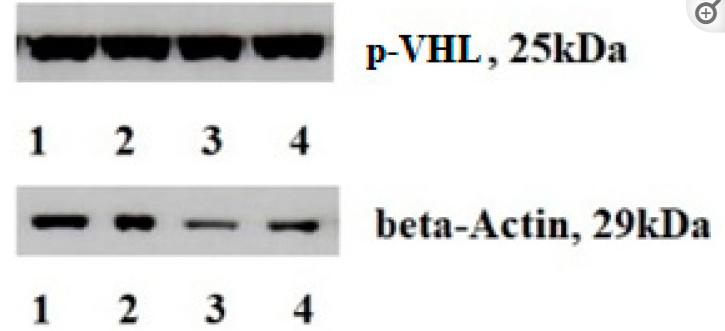Phospho-VHL (Ser68) Antibody - #AF8334
| Product: | Phospho-VHL (Ser68) Antibody |
| Catalog: | AF8334 |
| Description: | Rabbit polyclonal antibody to Phospho-VHL (Ser68) |
| Application: | WB IF/ICC |
| Cited expt.: | WB |
| Reactivity: | Human, Mouse, Rat |
| Prediction: | Pig, Bovine, Dog |
| Mol.Wt.: | 24 kDa; 24kD(Calculated). |
| Uniprot: | P40337 |
| RRID: | AB_2840396 |
Related Downloads
Protocols
Product Info
*The optimal dilutions should be determined by the end user. For optimal experimental results, antibody reuse is not recommended.
*Tips:
WB: For western blot detection of denatured protein samples. IHC: For immunohistochemical detection of paraffin sections (IHC-p) or frozen sections (IHC-f) of tissue samples. IF/ICC: For immunofluorescence detection of cell samples. ELISA(peptide): For ELISA detection of antigenic peptide.
Cite Format: Affinity Biosciences Cat# AF8334, RRID:AB_2840396.
Fold/Unfold
Elongin binding protein; G7 protein; HRCA 1; HRCA1; Protein G7; pVHL; RCA 1; RCA1; VHL 1; VHL; VHL_HUMAN; VHL1; VHLH; Von Hippel Lindau disease tumor suppressor; von Hippel Lindau syndrome; von Hippel Lindau tumor suppressor; Von Hippel Lindau tumor suppressor, E3 ubiquitin protein ligase; Von Hippel-Lindau disease tumor suppressor;
Immunogens
A synthesized peptide derived from human VHL around the phosphorylation site of Ser68.
- P40337 VHL_HUMAN:
- Protein BLAST With
- NCBI/
- ExPASy/
- Uniprot
MPRRAENWDEAEVGAEEAGVEEYGPEEDGGEESGAEESGPEESGPEELGAEEEMEAGRPRPVLRSVNSREPSQVIFCNRSPRVVLPVWLNFDGEPQPYPTLPPGTGRRIHSYRGHLWLFRDAGTHDGLLVNQTELFVPSLNVDGQPIFANITLPVYTLKERCLQVVRSLVKPENYRRLDIVRSLYEDLEDHPNVQKDLERLTQERIAHQRMGD
Predictions
Score>80(red) has high confidence and is suggested to be used for WB detection. *The prediction model is mainly based on the alignment of immunogen sequences, the results are for reference only, not as the basis of quality assurance.
High(score>80) Medium(80>score>50) Low(score<50) No confidence
Research Backgrounds
Involved in the ubiquitination and subsequent proteasomal degradation via the von Hippel-Lindau ubiquitination complex. Seems to act as a target recruitment subunit in the E3 ubiquitin ligase complex and recruits hydroxylated hypoxia-inducible factor (HIF) under normoxic conditions. Involved in transcriptional repression through interaction with HIF1A, HIF1AN and histone deacetylases. Ubiquitinates, in an oxygen-responsive manner, ADRB2.
Cytoplasm. Membrane>Peripheral membrane protein. Nucleus.
Note: Found predominantly in the cytoplasm and with less amounts nuclear or membrane-associated. Colocalizes with ADRB2 at the cell membrane.
Cytoplasm. Nucleus.
Note: Equally distributed between the nucleus and the cytoplasm but not membrane-associated.
Expressed in the adult and fetal brain and kidney.
The Elongin BC complex binding domain is also known as BC-box with the consensus [APST]-L-x(3)-C-x(3)-[AILV].
Belongs to the VHL family.
Research Fields
· Environmental Information Processing > Signal transduction > HIF-1 signaling pathway. (View pathway)
· Genetic Information Processing > Folding, sorting and degradation > Ubiquitin mediated proteolysis. (View pathway)
· Human Diseases > Cancers: Overview > Pathways in cancer. (View pathway)
· Human Diseases > Cancers: Specific types > Renal cell carcinoma. (View pathway)
References
Application: WB Species: Human Sample: ccRCC tissues
Restrictive clause
Affinity Biosciences tests all products strictly. Citations are provided as a resource for additional applications that have not been validated by Affinity Biosciences. Please choose the appropriate format for each application and consult Materials and Methods sections for additional details about the use of any product in these publications.
For Research Use Only.
Not for use in diagnostic or therapeutic procedures. Not for resale. Not for distribution without written consent. Affinity Biosciences will not be held responsible for patent infringement or other violations that may occur with the use of our products. Affinity Biosciences, Affinity Biosciences Logo and all other trademarks are the property of Affinity Biosciences LTD.


